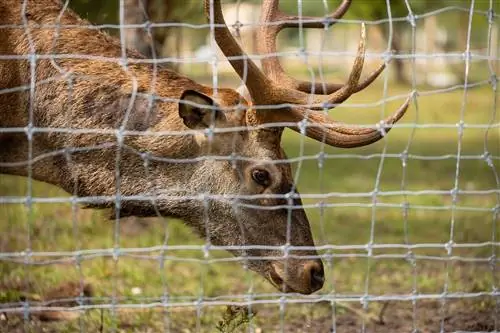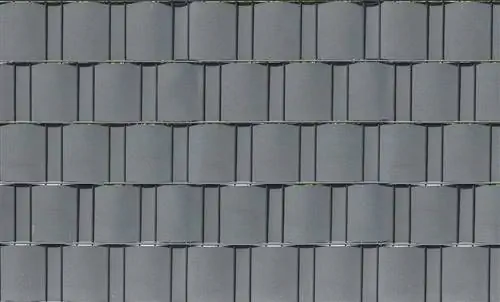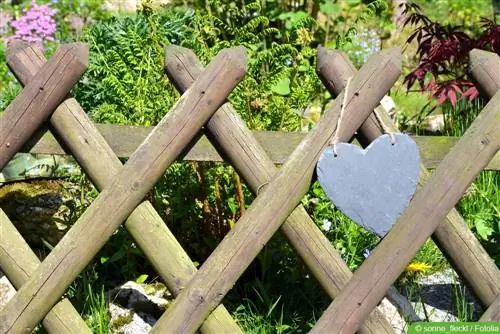- Author admin [email protected].
- Public 2023-12-17 03:39.
- Last modified 2025-01-24 12:45.
Anyone who owns property near a forest may be confronted with damage caused by wild animals. Gardens and young forest crops are often affected. The best solution is to build a wildlife fence. A modern game fence offers effective area protection against game browsing and damage caused by sweeping. This protective measure is not cheap, but it is particularly effective.
Legal information about wild fences
Wildlife fences generally do not require approval. However, the provisions of the Forest Act, nature conservation law and building law must be observed in detail. How long a wildlife fence has to remain up depends on the plants to be protected and the number of game animals. While deer usually only endanger the fresh buds of trees and a deer fence becomes unnecessary after five to seven years, protective fences against deer must remain in place for up to 15 years. The peeling damage caused by deer can only be effectively combated through individual protective measures once the Z-trees have developed.
Wild fence types
Depending on the size of the area and the amount of game, different types of wild fences are available. The simplest and most common wild fence is the classic post fence, whose posts support the fence mesh. Posts made of wood, plastic or metal can be used for post fences. A horde gate is an attractive alternative in that the fence elements can simply be nailed together and repaired or supplemented if necessary.
If the horde gate is no longer needed, it can simply rot on site. In the Alpine region, cable fences with pendulum and scissor supports are also possible. This type of fence is covered with sturdy steel cables and held in place by ground anchors. Electric fences require fewer posts and wires. However, it is important to note that live wires must be installed at different heights to deter animals of different sizes. Ultimately, anyone who wants to build a wildlife fence is faced with the question of how high the structure needs to be to provide effective protection.
- A game fence of 80 centimeters high is sufficient for hares and rabbits, while higher fences are required to protect against game.
- For wild boar the height is 1.20 meters, for roe deer it is 1.50 meters.
- A height between 1, 80 and 2 meters is recommended for red deer.
Building a wildlife fence
First, the route must be determined, i.e. the course of the fence. From this you calculate the need for wire and fence posts. Next you can start setting the posts, corner posts and struts. Four meters is usually sufficient as a post spacing; for Z-profiles, a distance of 2.50 to 3 meters is recommended. The end posts and corner posts must be able to carry the entire tensile load of the fence. That's why they should be embedded 60 to 80 centimeters deep into the ground and secured with struts. The struts should be attached to the top of the corner posts at an angle of 45 degrees. End posts and corner posts are best secured with an additional brace in the ground area. The insertion depth for the fence posts should be at least 40 to 60 centimeters, depending on the nature of the ground. To insert the piles, it is worth using special tools, such as a pile driver or pile driver. However, a hole drill and a sledgehammer also work well.
Tighten and fasten the game fence
Stretching a wildlife fence is teamwork. Two people each should roll out the knotted mesh along the erected fence posts, while two other people attach the beginning of the roll to the posts with staples. With Z-profiles, the wire is hooked in and secured. The wire mesh is clamped twice at the start and end posts so that the strong tensile forces can be absorbed. Meanwhile, the staples on the intermediate posts should not be driven in too tightly. Here the wire must still have some leeway so that it can be re-tightened if necessary. If two rolls of wire are to be linked together along the fence, you should use a wire tensioner.
Electric wild fence against wild boar infestation
If you want to protect yourself against wild boar infestation in your own garden or on your own property, you should build an electric wild boar fence. Before you start building the wildlife fence, you should first measure the property that is to be surrounded by the wildlife fence. The number of total meters are divided by three. This means you know how many fence posts you need before you buy the components for a wildlife fence. These fence posts are placed three meters apart.
Based on the total length of the perimeter of the property that is to be protected with the wildlife fence, you can also measure how long the net must be to conduct electricity and be attached to the posts. You also need three insulators per post to which the net is attached. In the electronic version, the central element of the wild fence is the forest energizer, which feeds the electricity into the network. You have to make sure that the game fence must be grounded.
Costs for a wildlife fence
If you buy the parts, such as posts, nets and fencing equipment, you pay between 25 and 50 euros per post for each post, provided they are steel posts. The grounding cable costs between 15 and 50 euros with a length of 50 to 100 meters. The wild energizer is available as a cordless device, battery device or as a 230V power supply. Depending on the model, the price starts at 90 euros. The more expensive models of wild fence netting devices cost between 250 and 400 euros.






